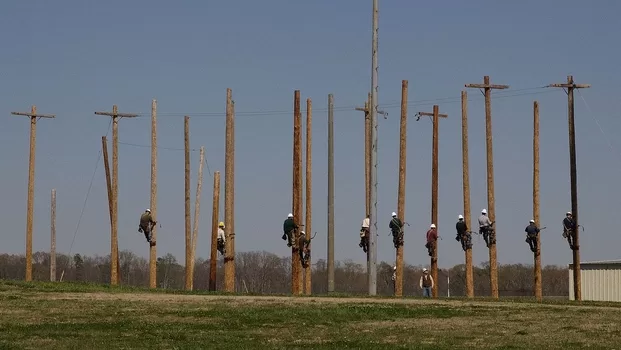The debate over the replacement of timber power poles with fire-resistant fibreglass composite poles has sparked controversy in New South Wales. The NSW Nationals and the logging industry are facing criticism for prioritizing profits over community safety and energy security.
Replacing timber power poles with fire-resistant fibreglass composite poles is a strategic move that enhances safety, durability, environmental sustainability, and economic efficiency. This transition is especially crucial in wildfire-prone regions, where the resilience and fire-resistant properties of fibreglass composite poles can significantly reduce the risk of fire-related damage and power outages.
Article continues after this advertisement:
Building Back Better to Be Applauded, Not Criticised
Susie Russell, Vice-President of the NCEC, expressed concern, stating, “Logging industry and NSW Nationals are putting profits for a few ahead of safety and energy security for regional communities.”
This response came after NSW Nationals leader Dugald Saunders urged the Minns Labor Government to reverse Essential Energy’s decision to replace ageing timber power poles with fibreglass composite poles.
Essential Energy, one of Australia’s largest energy distribution network providers, has announced plans to replace all of its NSW hardwood power poles with fibreglass by 2029.
This decision involves replacing at least 11,200 poles annually, including 2,200 in bushfire-prone areas, as part of a transition covering its 1.33 million pole network, excluding street lights, over the next five years.
Russell emphasized the importance of community safety, noting that timber power poles are not the best option for the region.
She praised Essential Energy’s move to protect North Coast communities from severe bushfires, stating, “It’s clear that timber power poles are not the best choice for our community. This move by Essential Energy is about protecting our region from the impacts of severe bushfires and should be applauded.”
A significant portion of the state’s timber power pole supply comes from areas proposed for the Great Koala National Park.
Woodcentral says “more than 80% of the state’s power poles are made from hardwood, with at least 50% of that supply coming from areas earmarked for the Great Koala Park National Park”.
Russell highlighted the benefits of moving to non-timber alternatives, which would support the creation of the park and leave the trees standing.
Justin Field from the Forest Alliance NSW echoed Russell’s sentiments, stating, “The only explanation for the timber industry and NSW Nationals to oppose this move is that they are trying to protect logging profits at the expense of community safety and resilience.”
Field pointed out that timber power poles are more susceptible to fire and that logging native forests increases the risk of high-intensity fires, further endangering local communities.
Field also emphasized the availability of alternatives to logging native forests. He noted the use of plantation pine for house frames and the growing popularity of composite decking and flooring for their fire resilience and reduced maintenance.
“It makes sense to go with materials more suited to our conditions,” he said.
Currently, most trees taken from native forests end up as cardboard or wood chips for export, which Field described as incredibly wasteful. He advocated for a shift to composite materials as a win-win solution.
Reflecting on the 2019/20 fires, Russell highlighted the prolonged power outages caused by burnt timber poles and the lengthy restoration process.
She pointed out that the electricity regulator determined the cost of transitioning to fibreglass composite poles to be $1.54 per year per household, a small expense for protecting against future power disruptions and enhancing community resilience.
“Taking timber from native forests is expensive and heavily subsidised by taxpayers to enable the industry to remain profitable so households are already paying for an inferior product which leaves their critical power supply more vulnerable,” Russell added.
She commended Essential Energy for their efforts to keep regional communities safer, saying, “There is lots of talk about building back better after the fires. Good on Essential Energy for acting to do their part to keep regional communities safer.”
The Case for Replacing Timber Power Poles with Fire-Resistant Fibreglass Composite Poles
The combination of improved safety, lower maintenance costs, and positive environmental impact makes fibreglass composite poles a superior alternative to traditional timber poles.
Fire Resistance
One of the primary advantages of replacing timber power poles with fire-resistant fibreglass composite poles is the significant improvement in safety. Fibreglass composite poles are inherently fire-resistant, which greatly reduces the risk of power poles igniting during wildfires.
This feature not only helps prevent the spread of fires but also enhances the overall safety of communities. Unlike timber poles, which can burn and collapse, fibreglass composite poles maintain their structural integrity during fires.
This ensures the continuity of the power supply and minimizes power outages during emergencies.
Durability and Longevity
Fibreglass composite poles offer exceptional durability and longevity. These poles are resistant to various environmental factors, including moisture, insects, and decay.
This resistance leads to a longer lifespan compared to timber poles, which can degrade over time due to these factors.
The superior durability of fibreglass composite poles reduces the need for frequent maintenance and replacement, resulting in lower long-term costs for utility companies.
Environmental Impact
From an environmental perspective, using fibreglass composite poles is a sustainable choice. This transition helps conserve forests and reduces the need for cutting down trees for timber poles, thereby contributing to the preservation of natural habitats and biodiversity.
The manufacturing and maintenance of fibreglass composite poles typically result in lower greenhouse gas emissions compared to the harvesting, processing, and transporting of timber poles. This reduction in emissions further supports environmental sustainability.
Economic Considerations
While the initial cost of fibreglass composite poles may be higher than that of timber poles, they prove to be cost-effective in the long run. The reduced maintenance and replacement costs, coupled with their longer lifespan, make fibreglass composite poles an economically viable solution.
The fire-resistant properties of these poles can lead to lower insurance premiums for utility companies due to the reduced risk of fire-related damage.
Technical Advantages
Fibreglass composite poles also offer several technical advantages. They possess high strength-to-weight ratios and flexibility, making them less likely to break under load or impact compared to timber poles.
Fibreglass composite poles are lighter than timber poles, making them easier and less expensive to transport and install. This characteristic is particularly beneficial in remote or difficult-to-access areas.
Examples of sustainable utility poles
Dulhunty Poles is a manufacturer and distributor of a unique range of innovative engineered geopolymer cement poles for a raft of applications, particularly for utility power.
Wagners Composite Fibre Technologies (CFT) produces durable, safe and environmentally friendly utility poles for energy infrastructure asset owners around the world.
Tencom’s FRP composite utility poles are designed to withstand a great number of natural disasters including tornadoes, hurricanes, earthquakes, strong winds, and forest fires.
Poletech have developed Australia’s first 100% Australian-made composite power pole.
Penguin Composites in Australia also manufacture fibreglass-reinforced composite utility poles.
Creative Composites Group‘s Fiber-Reinforced Polymer (FRP) is often used as an advanced material for utility poles.
Related stories
The End of VicForests Begins New Era of Logging
Funding Models To Support Indigenous Stewardship of Forests
Important Koala Habitat Logged to Undermine Koala Sanctuary
Bamboo: The Sustainable Alternative to Hardwood Flooring
Australia’s elusive Quolls headed for extinction
Greater Glider heading for extinction
Urgent Need for Transitioning to Plantation Timber
Plantation forestry in Australia
Transition to plantation timber wins for nature and industry
What can NSW Government do to stop koala extinction?
Can and should we bring animals back from Extinction?
The battle to save Koalas from extinction in Australia




